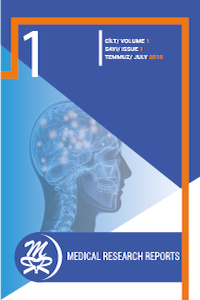Covid-19 Enfeksoyununun Beslenme ile İlişkisi
2019 yılının son aylarından sonra kendini gösteren SARS-COV2 (Covid-19) salgını mayıs ayı itibari ile 4 milyondan fazla vakaya sebep olmuştur. Sosyal olarak alınan önlemler dışında kişilerin beslenme alışkanlıkları da hastalığın seyrinde önemli rol oynamaktadır. Yüksek doymuş yağ, rafine karbonhidrat ve şeker içeriği fazla olan fakat lif, doymuş yağ ve antioksidan içeriği az olan tipik batı diyeti ile beslenen hastaların genel sağlık durumu ve bağışıklık sistemi kötü etkilenmektedir. Bu beslenme tarzı Covid-19 enfeksiyonunun risk faktörü olduğu obezite ve hipertansiyon gibi metabolik hastalıklara sebep olmaktadır. Bu sebepten Covid-19 enfeksiyonuna yakalanan astalardan bu diyet ile beslenenlerin prognozu daha kötü seyirli olmuştur. Sunduğumuz bu yazıda Covid-19 enfeksiyonunda yapılan bazı çalışmalarda hastaların beslenme alışkanlığı ile hastalığın seyri arasındaki ilişki açıklanmaya çalışılmıştır.
Nutritional Behavior During Covid-19 Enfection
Since end of the 2019 there has been an infection caused by SARS-COV2 virus all around the World. It caused more than 4 million case as of May. Other than the social precautions, nutritional behavior of an subject has an important role on the disease progress. The diet contain high amount of saturated fat, refined carbohydrate and sugar but less amount of fibre, unsaturated fat and antioxidants are effect badly the immune system and general health status. This nutrition behavior also cause metabolic desaeses like diabetes mellitus, hypertention and obesity which they are high risk facttors for Covid-19. In this report we aimed to understand relation between the Covid-19 enfection progress and the nutritional behavior.
___
- 1. Zabetakis I, Lordan R, Norton C, Tsoupras A. COVID-19: The Inflammation Link and the Role of Nutrition in Potential Mitigation. Nutrients. 2020;12(5):E1466. Published 2020 May 19. doi:10.3390/nu12051466
- 2. Butler MJ, Barrientos RM. The impact of nutrition on COVID-19 susceptibility and long-term consequences [published online ahead of print, 2020 Apr 18]. Brain Behav Immun. 2020;S0889-1591(20)30537-7. doi:10.1016/j.bbi.2020.04.040
- 3. Laviano A, Koverech A, Zanetti M. Nutrition support in the time of SARS-CoV-2 (COVID-19). Nutrition. 2020;74:110834. doi:10.1016/j.nut.2020.110834
- 4. Orioli L, Hermans MP, Thissen JP, Maiter D, Vandeleene B, Yombi JC. COVID-19 in diabetic patients: Related risks and specifics of management. Ann Endocrinol (Paris). 2020;81(2-3):101-109. doi:10.1016/j.ando.2020.05.001
- 5. Correia MITD. Nutrition in times of Covid-19, how to trust the deluge of scientific information. Curr Opin Clin Nutr Metab Care. 2020;23(4):288-293. doi:10.1097/MCO.0000000000000666
- 6. Moynihan AB, van Tilburg WA, Igou ER, Wisman A, Donnelly AE, Mulcaire JB. Eaten up by boredom: consuming food to escape awareness of the bored self. Front Psychol. 2015;6:369. Published 2015 Apr 1. doi:10.3389/fpsyg.2015.00369
- 7. Rodríguez-Martín BC, Meule A. Food craving: new contributions on its assessment, moderators, and consequences. Front Psychol. 2015;6:21. Published 2015 Jan 22. doi:10.3389/fpsyg.2015.00021
- 8. Muscogiuri G, Barrea L, Savastano S, Colao A. Nutritional recommendations for CoVID-19 quarantine. Eur J Clin Nutr. 2020;74(6):850-851. doi:10.1038/s41430-020-0635-2
- 9. Semba, R. D. (1994). Vitamin A, immunity, and infection. Clinical Infectious Diseases, 19(3), 489-499.
- 10. Siddiqi, H. K., & Mehra, M. R. (2020). COVID-19 illness in native and immunosuppressed states: A clinical–therapeutic staging proposal. The Journal of Heart and Lung Transplantation, 39(5), 405.
- 11. Timoneda, J., Rodríguez-Fernández, L., Zaragozá, R., Marín, M. P., Cabezuelo, M. T., Torres, L., ... & Barber, T. (2018). Vitamin A deficiency and the lung. Nutrients, 10(9), 1132.
- 12. Mosekilde, L. (2005). Vitamin D and the elderly. Clinical endocrinology, 62(3), 265-281.
- 13. Grant WB, Lahore H, McDonnell SL, et al. Evidence that Vitamin D Supplementation Could Reduce Risk of Influenza and COVID-19 Infections and Deaths. Nutrients. 2020;12(4):988. Published 2020 Apr 2. doi:10.3390/nu12040988
- 14. Raharusun, P. (2020). Patterns of COVID-19 Mortality and Vitamin D: An Indonesian Study. Available at SSRN 3585561.
- 15. Muscogiuri G, Altieri B, Annweiler C, Balercia G, Pal HB, Boucher BJ, et al. Vitamin D and chronic diseases: the current state of the art. Arch Toxicol. 2017;91:97–107
- 16. Wessells, K. R., & Brown, K. H. (2012). Estimating the global prevalence of zinc deficiency: results based on zinc availability in national food supplies and the prevalence of stunting. PloS one, 7(11), e50568.
- 17. Barnett, J. B., Hamer, D. H., & Meydani, S. N. (2010). Low zinc status: a new risk factor for pneumonia in the elderly?. Nutrition reviews, 68(1), 30-37.
- Yayın Aralığı: Yılda 3 Sayı
- Başlangıç: 2017
- Yayıncı: M. Tayyib KADAK
Sayıdaki Diğer Makaleler
COVID-19 SALGININDA HALK SAĞLIĞI YÖNETİMİ
COVID-19 ve Psikiyatrik Bozukluklar
İhsan OKUR, Ömer Faruk DEMİREL
SARS-COV 2 Enfeksiyonu Olan Hastanın Radyolojik Görüntülemesi
Covid-19 Pandemisinin Yenidoğan Sağlığı Üzerine Etkileri
Management of Hospitals during COVID-19 pandemic
Nimetcan MEHMET, Abdul-ghaffar DONKOR, Mehmet Enes GÖKLER
Covid-19 Enfeksoyununun Beslenme ile İlişkisi
Covid 19 Pandemisinde Akciğer ve Göğüs Hastalıkları
COVİD-19 PANDEMİSİ VE KARANTİNA SÜRECİNDE ÇOCUK RUH SAĞLIĞI
Koronavirüs 2019 Hastalığı (COVID-19) ve Gebelik
